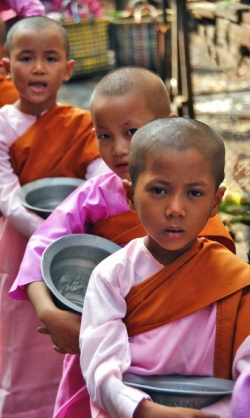Dashabhumika-sutra
十地経 (Skt Dashabhumika-sutra; Chin Shih-ti-ching; Jpn Juji-kyo ) Dasabhumika Sutra: Also known as the 26th chapter of the Avatamsaka Sutra or the Sutra on the Ten Stages.
See "bodhisattva levels."
- A sutra that deals with the ten stages of development.
In the system of the fifty-two stages of bodhisattva practice enumerated in the Jeweled Necklace Sutra, the ten stages of development correspond to the forty-first through the fiftieth stages.
The Ten Stages Sutra corresponds to the "Ten Stages" chapter of the Flower Garland Sutra.
It is generally thought that in India the Ten Stages Sutra was first produced and later included in the voluminous Flower Garland Sutra when the latter was compiled.
The Sanskrit text, a Tibetan translation, and several Chinese translations of the Ten Stages Sutra are extant.
In the theory of the ten bhumi in the Dasabhumika-sutra, the stages after the eighth are called anabhoga (non-endeavor) and are clearly distinguished from the prior seven stages.
It may be assumed that the key to understanding this may lie in adhisthana.
Attention is drawn to a term appearing in the opening section of the eighth stage, svadhisthita-tathagatadhisthana, which refers to the bodhisattvas who receive the adhisthana of the tathagatas.
These bodhisattvas are grounded in the purva-pranidhanadhisthana, or adhisthana as the original vow following from the tathagatas.
These bodhisattvas, who now possess for the first time the power of their vows having attained anutpada-dharma-ksanti on the eighth stage, receive the jñanabhinirharamukha of the tathagatas, and having done so shift to unrestricted bodhisattva practices.
This can also be considered an aspect of adhisthana.
Even after they begin their unrestricted activities, the adhisthana of the tathagatas forms the basis for the bodhisattvas' activities which are by themselves ineffectual.
This is seen in several passages as the basis of the eighth stage.
Next, two meanings may be conceived of for the adhitisthati that manifests through the unrestricted activities of the bodhisattvas: (1) determination, or (2) establishing.
For (1), to guide beings in the correct direction in the bhajana-loka, the bodhisattvas change their own forms (svakaya) to conform with that of particular beings.
In other words, it is the determination of the bodhisattvas to change their appearance through the power of their vows, and accordingly such bodies arise (adhitisthati).
On the other hand, (2) on the basis of the bodhisattvas' wisdom and insight they perceive that their own bodies and the bodies of all sentient beings are the same and attain the realization of the identity of self and other.
The bodhisattvas for the first time attain their true role in liberating beings through the power of their vows.
The bodhisattva's body is established (adhitisthati) without restrictions among the bodies of the sentient beings and all the ten bodies.
Reaching this level of unimpeded practice, the bodhisattvas lose all sense of relativity and can engage in all aspects of non-discriminating bodhisattva practice.
As outlined above, two aspects are explained in the text: that of the ineffectuality of the eighth stage, and the adhisthana of the tathagatas and the unrestricted practice of the bodhisattvas based on that.
importance in Ti-lun
Buddhism: Avatamsaka (Huayan/Kegon)
...of the Avatamsaka or Huayan school in China was the Dilun school, which was based on the Shiyidijinglun or Dilun, an early 6th-century translation of the Dashabhumika-sutra (“Sutra on the Ten Stages”). Since this work, which concerns the path of a bodhisattva to Buddhahood, was part of the Avatamsaka-sutra.
stages of bhūmi
...The stages (which are also termed vihāras, “stations”) appear as 7, 10, and 13 in various texts, but the scheme that is most commonly agreed upon is the one given in the Daśabhūmika-sūtra (“The Sūtra on the Ten Spiritual Levels”). It lists the progressively superior stages as: (1) pramuditā (“joyful,”



